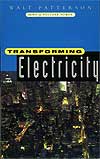
Transforming Electricity:
The Coming Generation of Change
by Walt Patterson
Royal Institute of International
Affairs/ Earthscan Publications,
1999, 224 pages
Walt Patterson is a physicist by training, an entertaining and lucid writer (he seldom misses a chance at wordplay — note the title of this book), a fan of jazz and baseball and real ale, and an incisive popularizer of important but complicated matters. And yes, he’s my friend. Remind me to tell you some day about several hours we spent years ago in the bookstores on and near Telegraph Ave. in Berkeley, scouring dusty shelves for out-of-print popular books on atomic energy, The Atom Is Your Friend and such.
Patterson’s latest book, Transforming Electricity, written for a London policy think tank, undertakes the daunting task of explaining how electricity works; why the dominance of alternating current over direct current came about and why it could change; how generation and distribution schemes have developed over the past century; and how we’re in for dramatic changes, though of what complexion remains to be seen.
Patterson takes it as a given that the 2 billion or so people who aren’t yet electrified will demand to become so. He also suggests that the nuclear age has come and mostly gone. Indeed, he argues that the reliance on gigantic central-station generating plants will swiftly decline, for a wide variety of reasons. These include inefficiency (much waste is involved in long-distance transmission of electricity), environmental impacts (there are dozens, including polluted skies, ravaged rivers, irradiated croplands, and our troublesome global greenhouse), and fairness to the less fortunate.
And how, one must wonder, can we substantially increase the world’s generation and consumption of electricity and still avoid melting Antarctica?
A major feature of our electricity future, in Patterson’s view (and this book is buttressed by hundreds upon hundreds of studies and reports and the like), is natural gas. Gas burns clean, producing far less troublesome emissions than does coal. It doesn’t involve the flooding of beautiful and productive river valleys as does hydroelectric power, and it doesn’t leave long-lived and dangerous wastes as do nuclear power plants.
The exciting news, however, of the past few years is the development of very small plants using gas turbines or fuel cells to generate electricity, sometimes both heat and electricity depending on the application. Thus, Patterson sees a possible future in which office buildings would have on-site generating plants in their basements, a vastly more efficient setup than the present one, in which most electricity is delivered from many miles away at great cost and involving much waste.
Gas isn’t the only feature of a future supply system, of course. Sunlight for heating and generation of electricity through photovoltaic cells should play a major role as well. We shan’t go through the whole litany here; read it for yourself.
Patterson cites figures from the Worldwatch Institute that are difficult to argue with, despite what you may read in mainstream media that still insist on quoting cranks side-by-side with serious scientists. To wit, the 15 warmest years ever recorded on planet Earth have all occurred since 1979. Icecaps in the Andes are melting, glaciers in the Alps are shrinking, and sea ice around Antarctica is breaking up. The generation of electricity is one of the major causes of global warming, and it must be addressed.
The coming debate over how to generate the electricity to run our computers and faxes and CD players and a thousand other gadgets — not to mention power the motors that may one day run many of our cars and trucks — is in full swing. The outcome will affect us all. This book is a splendid introduction to what it’s all about.


